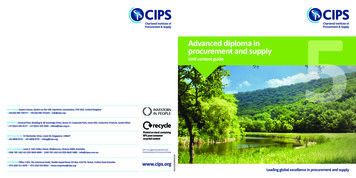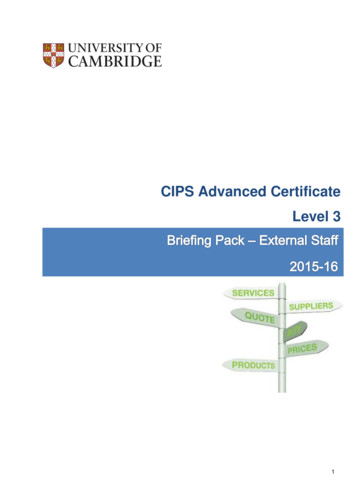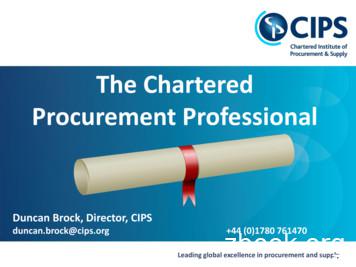CIPS Level 6 Professional 6 Diploma In Procurement And Supply
CIPS Level 6ProfessionalDiploma inProcurementand SupplyRef: 603/3926/32018 SyllabusVersion 16
YourqualifıcationCIPS qualifications are regulated internationally to ensure we offer a recognised, professionalstandard in procurement and supply. CIPS Level 6* Professional Diploma in Procurement andSupply is a vocationally related professional qualification. Formal recognition is included withinthe regulatory frameworks of an increasing number of countries such as the UK (England, Walesand Northern Ireland), UAE (including Dubai) and Africa (including Zambia). Further informationon this recognition and the details of corresponding qualifications levels for other internationalqualifications frameworks are detailed on our website. CIPS members can have the confidencein our regulated qualifications, which reliably indicate the standard of knowledge, skills andunderstanding that you, as a learner, are required to demonstrate.The CIPS Level 6 Professional Diploma in Procurementand Supply is for those who want to specialise in aspecific occupation, occupational area or technical role. Itrepresents the final level of qualification required by thosewho are working towards MCIPS Chartered Procurementand Supply Professional, which is recognised worldwideas the professional standard for procurement and supplypractitioners.Entry levelLevel 2Certificate inProcurementand SupplyOperationsBuilding on the knowledge and skills learned at the CIPSLevel 5 Advanced Diploma in Procurement and Supply.This qualification supports individuals who are workingat or aspiring to the Professional level of the CIPS GlobalStandard for Procurement and Supply. It is designed forexperienced members of the profession who are expectedto lead procurement teams within an organisation andinfluence the board to adopt leading-edge procurementstrategies thereby establishing best practice.Entry levelHighest entry levelLevel 3AdvancedCertificate inProcurementand SupplyOperationsLevel 4Diploma inProcurementandSupplyLevel 5AdvancedDiploma inProcurementand SupplyNext stepsOn successful completion you will need to formally apply tobe upgraded to MCIPS, or with an up to date CIPS EthicalProcurement and Supply certificate you will be eligible to upgradeto MCIPS Chartered Procurement and Supply Professional.In order to apply you must be a current member.* Refers to levels within the UK RQF. Other regulatory bodies may have different corresponding levelsBased on the Professional competency level of CIPS Global StandardLevel 6ProfessionalDiploma inProcurementand Supply
60What will I study?Creditsrequired forcompletionFour CORE modules make up 42 of the required creditsCORE Level 6 Strategic Ethical Leadership (L6M1)12CREDITSCORE Level 6 Global Commercial Strategy (L6M2)12CREDITSCORE Level 6 Global Strategic Supply Chain Management (L6M3)1242Credits madeup of COREmodulesCREDITSCORE Level 6 Future StrategicChallenges for the Profession(L6M4)6CREDITSChoose three ELECTIVE modules to make up the final 18 remaining creditsELECTIVE Level 6 Strategic Programme Leadership (L6M5) 6 creditsELECTIVE Level 6 Commercial Data Management (L6M7) 6 creditsELECTIVE Level 6 Innovation in Procurement and Supply (L6M8) 6 creditsELECTIVE Level 6 Supply Network Design (L6M9) 6 creditsELECTIVE Level 6 Global Logistics Strategy (L6M10) 6 creditsWho is it for?For those who are successful in completing theCIPS Level 5 Advanced Diploma in Procurementand Supply; this represents the final level of CIPSqualifications for those working towards MCIPSChartered Procurement and Supply Professional.What will I learn?Building on the knowledge and skills learned at theCIPS Level 5 Advanced Diploma in Procurement andSupply, you will be able to demonstrate strategicknowledge and leadership skills and find solutionsto complex problems. It is designed to developtransferable workplace skills such as excellentcommunication and the ability to work in and leada team. Employers have identified that the ability tothink strategically and lead and influence policy andthinking are essential for progression.18Credits made upof your choice ofELECTIVEmodulesYou will gain an understanding of differentperspectives and theories and will be able to criticallyanalyse, interpret and evaluate complex information,concepts and ideas.Entry requirementsYou will need to have achieved CIPS Level 5 AdvancedDiploma in Procurement and Supply.Credit valuesTo gain a qualification you are required to complete atotal number of credits. This is a way of quantifying therequired number of study hours. 1 credit is equivalent to10 hours of study. Each module is given a credit value of6 or 12 credits.Total credits requiredfor completion6003
About ourexams and yourstudy commitmentsObjective Response exam format (OR)These questions allow you to select a response from a list of possible answers.You will find these types of exams across all our qualifications levels and theyare marked by computer and then moderated by CIPS examiners.Constructed Response exam format (CR)These questions require you to create or ‘construct’ a response to the questionsuch as an essay or case study. You will find this type of exam in our diplomalevel qualifications and they will be marked by subject expert examiners.Your total qualification time (TQT)The TQT indicates the overall number of guided learning hours,additional self-study and assessment time that is required.Guided learning hours (GLH)It is expected that you will undertake 250 GLH. The definition of guided learninghours is: ‘A measure of the amount of input time required to achieve thequalification. This includes lectures, tutorials and practicals, as well assupervised study in, for example, learning centres and workshops’.Self-study requirement (SSR)Additionally, we recommend that you also commit to at least 335 SSRhours. This includes wider reading of the subject areas and revision to giveyourself the best preparation for successfully achieving the qualification.Total exam timeAll the modules in CIPS qualifications are assessed by an examination.cips.org/qualificationsORCR600TQT HRS250GLH HRS335SSR HRS15HRS
CCORE MODULEStrategic EthicalLeadership[L6M1]CIPS GLOBALSTANDARD1.6 1.7 9.79.8 10.4 11.5CRCONSTRUCTEDRESPONSE EXAM3HRSEXAM DURATIONHOURS120Module purposeOn completion of this module, learners will be able to critically evaluate leadership skills andbehaviours required to achieve organisational and stakeholder commitment to strategicimprovements and change and also appreciate ethical practices, standards and regulationsthat impact on the procurement and supply function.Module aim(s)Globalisation and the ever changing markets in which organisations operate requireeffective leaders who are able to think and act in a strategic manner. This is particularly truefor those who lead the procurement and supply function ensuring that it makes a positivecontribution to overall organisational success. Strategic Leadership is the ability to make andcommunicate decisions that enhance the prospects for the organisation’s long-term successwhile maintaining long-term financial stability. This module is designed for those professionalswho are expected to deliver effective and efficient procurement and supply. It emphasisesthe leadership skills and behaviours required for the achievement of the objectives andimprovements sought by the organisation.HRSMODULELEARNINGTIME12Credit valueCREDITS05
Learning outcomes, assessment criteria and indicative content1.0 Understand and apply leadership skills andbehaviours that are appropriate for strategicallyimproving the procurement and supply chain function2.0 Understand and apply communication planningtechniques and analyse their influence on individualsinvolved in the supply chain1.1 Critically evaluate the differences between leadershipand management Defining leadership The role of a leader and the activity of leadership The importance of leadership The differences between management andleadership Situational leadership The continuum of leadership behaviour The forces in deciding the type of leadership Transformational and inspirational leadership2.1 Evaluate influencing styles that can be used in theeffective leadership of a supply chain Implementing a vision of improved procurement andsupply chain management Models for managing in four different directions The relevance of managing upwards and across toachieve desired results for improved supply chainmanagement The merits of escalation as a means of influencing A range of influencing styles for cross functionalleadership both within and outside the bounds offormal teams1.2 Critically analyse approaches to leadershipfor improving procurement and supply chainmanagement The qualities or traits approach to leadership The functional or group approach, including actioncentred leadership Styles of leadership including the authoritarian orautocratic, democratic and laissez-faire styles Contingency theories for leadership such as path-2.2 Compare leadership techniques that can be used toinfluence personnel involved in a supply chain Assessing the readiness of followers or groups Leaders attitudes to people Management by objectives and establishing KPIs Measures of effectivenessSelf-developmentEmotional intelligencegoal theory2.3 Evaluate how to create a communication plan toinfluence personnel in the supply chain Stakeholder analysis including primary, secondaryand key stakeholder How to obtain buy in to supply chain strategies fromstakeholders Perspectives on stakeholder mapping How the use of the intranet and Internet websites forpublishing informationcips.org/qualifications
3.0 Understand and apply methods to overcomeleadership challenges faced by procurement andsupply chain managers4.0 Understand and apply ethical practices, standardsand regulations that impact on the procurement andsupply function3.1 Contrast the sources of power and how they canbe used to overcome common challenges faced byprocurement and supply chain leaders Perspectives on individual power Processual, institutional and organisational levels ofpower Perspectives on organisational power The balance between order and flexibility4.1 Examine ethical practices and standards that apply toglobal supply chains Ethical codes of practice Due diligence on suppliers Contractual clauses Leading ethical practices and standards Developing a culture of commitment to achieveethical codes and practices Initiatives and policies created by leading bodiessuch as: CIPS Code of Conduct Traidcraft The Walk Free Foundation UN ILO3.2 Analyse how equality and diversity issues relating tothe supply chain can be used to improve strategiceffectiveness Defining diversity, equality and inclusion The benefits of diversity in organisations The impact of discrimination, harassment andvictimisation Developing and implementing policies to enhancediversity4.2 Assess regulations that impact on the ethicalemployment of people 3.3 Evaluate methods of change management that can beused to develop the supply chain The nature of organisational changePlanned organisational changeDealing with resistance to changeEffective change managementRegulations such as: Discrimination, equality and diversity Employee redundancy and dismissal Working time and staff payment International labour codes Health and safety at work Minimum/fair wages3.4 Assess methods for resolving conflict with internaland external stakeholders to support change in thesupply chain Contingency models of organisationsThe functions of the informal organisationThe positive and negative outcomes of conflictStrategies for resolving conflictIncremental and transformational change07
GlobalCommercialStrategy[L6M2]Module purposeOn completion of this module, learners will be able to evaluate the concept of commercialglobal strategy and assess the challenges and main elements associated with theformulation and implementation of a commercial strategy and understand the impact offinance on strategic decision making.Module aim(s)The global agenda is becoming more and more prevalent in organisational success. Asorganisations increase overseas development, investment and sourcing, business leadersare to formulate and implement global commercial strategies. This module is designed forprofessional procurement and supply chain leaders and takes as its focus the development;configuration and implementation of global commercial strategy to enable such leaders tohelp organisations achieve competitive advantage.CCORE MODULECIPS GLOBALSTANDARD1.7 2.5 2.6CRCONSTRUCTEDRESPONSE EXAM3HRSEXAM DURATIONHOURS120HRSMODULELEARNINGTIMECredit value 12CREDITScips.org/qualifications
Learning outcomes, assessment criteria and indicative content1.0 Understand and apply the concept of commercialglobal strategy in organisations1.1 Evaluate characteristics of global strategic decisions inorganisations The characteristics of strategic decisions The vocabulary of strategy Strategic versus operational management The strategic position Strategic choices Strategy in action2.0 Understand and apply tools and techniques toaddress the challenges of global supply chains2.1 Assess methods to analyse the global supply chain STEEPLED The use of benchmarking Determining measurable outcomes of success Devising metrics of performance The macro environment and the STEEPLED (social,technical, economic, environmental, legislative,ethical and demographic) framework Competitive forces- the five forces framework The industry and product life cycleCycles of competition2.2 Evaluate the regulatory influences on the globalsupply chain Licensing of imports and exports Controls through import and export tariffs and duties Price and service controls exercised by industryregulators and international bodies The regulations that impact on the employment ofpeople, such as: Discrimination, equality and diversity Redundancy and dismissalWorking time and paymentHealth and safetyMinimum/fair wagesModern slavery3.0 Understand strategy formulation and implementation3.1 Evaluate how corporate and business strategicdecisions impact on supply chains Strategic directions: market penetration,consolidation, product development and marketdevelopment Diversification: related and unrelated Portfolio matrices: growth/share, directional policyand parenting matrix Drivers of internationalisation Global, regional and local dimensions to strategicchoice3.2 Evaluate how organisational strategy can beimplemented in supply chains Methods of pursuing strategies: organic, mergersand acquisitions or strategic alliances Strategy evaluation: suitability, acceptability andfeasibility Managing intended and realised strategy Strategy development in uncertain and complexconditions3.3 Analyse the relationship between strategy andcorporate, business and functional structures inorganisations Structural types: simple, functional, multidivisional,matrix and transnational Aligning the supply chain to the organisationalstructure Centralised, devolved and hybrid structures Forming structures on lead buyers networks3.4 Analyse the management of resources to support thedevelopment and implementation of strategy People as a resource Managing information The role of technology Managing finance: the financial aspects of valuecreation Funding strategy development and implementation09
4.0 Understand financial aspects that affect procurementand supply4.1 Assess how costs and finance can impact on supplychains The financial objectives of different organisations(e.g. value for money, maximising shareholderwealth) The costs of materials, labour and overheads Funding working capital and credit insurance Project funding Medium and long term financing options Corporate financing decisions in investment, financeand dividends4.2 Evaluate methods for managing the volatility ofcurrencies in supply chains Fixed and floating exchange rates Demand and supply factors in foreign exchange andthe reasons for exchange rate volatility Spot, forward and derivative instruments in foreignexchange Services provided by the banking sector in foreignexchange4.3 Analyse methods for managing the volatility ofcommodities in supply chains Demand and supply factors in commoditiesThe differentiation of commoditiesSoft and hard commodity marketsSpeculation in commodity marketsThe use of spot, forward, futures and hedging in thebuying and selling of commoditiesThe use of a Contract for Difference (CFD) in thebuying and selling of commoditiescips.org/qualifications
CCORE MODULECIPS GLOBALSTANDARD4.6 6.9 8.6CRCONSTRUCTEDRESPONSE EXAM3HRSEXAM DURATIONHOURSGlobal StrategicSupply ChainManagement[L6M3]Module purposeOn completion of this module, learners will be able to evaluate the influence of strategicsupply chain management and assess the methods which are available to measure, improveand optimise supply chain performance.Module aim(s)One of the significant impacts of globalisation has been a marked increase in the complexity ofthe supply chain and associated networks. These challenges require procurement and supplyleaders to develop and lead modern day supply chains and understand the vital role thatthey have in the overall success of corporate and business strategy. This module is designedfor such professionals as it focuses on the development, implementation, monitoring andoptimisation of global supply chains and on the strategic influence of such chains on theachievement of competitive advantage.120HRSMODULELEARNINGTIME12Credit valueCREDITS11
Learning outcomes, assessment criteria and indicative content1.0 Understand how strategic supply chain managementcan support corporate business strategy2.0 Understand and apply supply chain design tools andtechniques1.1 Assess the relationship between functional, businessand corporate levels of strategy The relationship between the supply chain, businessand corporate levels of strategy The impact of supply chain management on businessand corporate performance The impact on profitability of the supply chain Supply chain risks and their impact on business andcorporate performance2.1 Compare approaches to segmentation Approaches to segmenting customers and suppliers Managing the product and service mix Creating strategies for the different tiers of a supplychain1.2 Evaluate the contribution of strategic supply chainmanagement Creating sources of competitive advantage such ascost, improved quality, time to market, product andservice differentiation Enterprise profit optimisation The use of outsourcing to achieve competitiveadvantage Offshoring and sourcing from low cost countries Quality improvement methodologies in the supplychain1.3 Evaluate the impact of market change on strategicsupply chain management STEEPLED (social, technical, economic,environmental, legislative, ethical and demographic)factors and their impact and risks on supply chains Distinguishing between disruptive and incrementalchange Changing markets and market volatilityThe impact of globalisation on supply chainsAssess the supply chain risks of achieving expectedinternational minimum standards. 1.4 Contrast approaches to develop and implementstrategic relationship management Models of strategic alignmentCustomer and supplier relationship managementMethodologies for the implementation of strategicrelationship managementcips.org/qualifications2.2 Assess approaches to developing networked supplychains Supply chain flows and the use of supply chain andvalue stream Tiering in supply chains and the use of networksourcing Identifying value added activities and the value chainin supply chain networks Network optimisation modelling The use of reverse logistics in supply chain networks2.3 Assess the role of distribution systems Channel designThe impact of e-commerce on distribution networksLogistics flow path des
CIPS Level 6* Professional Diploma in Procurement and Supply is a vocationally related professional qualification. Formal recognition is included within the regulatory frameworks of an increasing number of countries such as the UK (England, Wales and Northern Ireland), UAE (including Dubai) and Africa (including Zambia). Further information on this recognition and the details of corresponding .
CIPS Asia PacificIG Rochester Drive, Level HJ, Singapore, GINLIM TPLK LNFN NMHG FPLK LNFN NMHH Einfosg@cips.org CIPS AustralasiaLevel H, KHF Collins Street, Melbourne, Victoria IFFF, Australia TGIFF MLK GJH/PLG (F)I OLHO LFFF FGIFF MLK GJI/PLG (F)I OLHF KJNN Einfo@cipsa.com.au CIPS MENAOffice GMFI, The Fairmont Hotel, Sheikh Zayed Road, PO Box GGOMMJ, Dubai, United Arab Emirates TPOMG (F)J IGG .
CIPS Level 5 5 Advanced Diploma in Procurement and Supply Ref: 603/3925/1 6\OODEXV Version 1 Fhyzics Business Consultants Pvt. Ltd. An Approved Study Centre of CIPS, UK www.IISCM.org cs@fhyzics.net 91 900-304-9000. Your TXDOLIÂFDWLRQ Next steps 7KLV TXDOL 4FDWLRQ SURYLGHV SURJUHVVLRQ WR WKH CIPS Level 6 Professional Diploma in Procurement and Supply. 5HIHUV WR OHYHOV ZLWKLQ WKH 8. 54 .
The University CIPS Level 3 Programme 2.1. About the CIPS Programme The University’s CIPS Level 3, Advanced Certificate in Procurement and Supply Operations programme is partly funded through the Finance Division. You may apply if you work in one of the University colleges, the University Press or Cambridge Assessment or other associated institution, although funding will be requested from .
Leading global excellence in procurement and supply 1 The Chartered Procurement Professional Duncan Brock, Director, CIPS duncan.brock@cips.org 44 (0)1780 761470 . Leading global excellence in procurement and supply 2 Introducing CIPS Chartered Body Charitable Status Awarding Body Membership Organisation CIPS for Business . Leading global .
platforms/channels,, you agree to accept any changes made to the terms and conditions. CIPS Membership Subscriptions and MyCIPS CIPS Membership subscriptions and all CIPS membership fees quoted are for annual subscriptions (12- months). You are required to renew and mak
CIPS Position on Practice P&SM: Contract . Management . The activities of a buyer before, durin g and after a contract is signed, to ensure that all parties to the contract understand and fulfil their contractual obligations. CIPS members can record one CPD hour for reading a CIPS Knowledge
It is designed as a follow on from the CIPS Level 2 Certificate in Procurement and Supply Operations as learners are expected to develop, use and apply the professional language and skill sets introduced at Level 2 within a practical working environment. Individuals will be working at the Tactical but moving towards the Operational level of the CIPS Global Standard for Procurement and Supply .
CIPS Level 3 Advanced Certificate in Procurement and Supply Operations is designed for individuals who will be working at the Tactical but moving towards the Operational level of the CIPS Global Standard for Procurement and Supply. This is the first level of






















